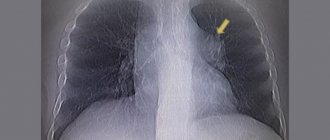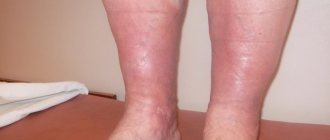von Willebrand disease
Von Willebrand disease is a congenital pathology manifested by a deficiency of von Willebrand factor and characterized by increased bleeding. The interaction of platelets with the walls of blood vessels is disrupted, which increases capillary fragility. The incidence is similar to that for hemophilia and is 10 cases per 100 thousand people.
Reference. Von Willebrand factor is a blood plasma glycoprotein that plays an important role in hemostasis (maintaining the fluid state of the blood).
The disease is named after its discoverer, Erik Adolf von Willebrand (1870–1949), a Finnish doctor with Russian noble roots. The first names of the considered pathology of the hematopoietic system were given by Willebrand himself - “pseudogemophilia”, “constitutional thrombopathy”. Later, American doctors discovered that the disease was based on protein, not platelets.
Eric von Willebrand - discoverer of the disease of the same name
The essence of von Willebrand disease is a blood clotting disorder. It is more common in women and is transmitted from mother to child. And it manifests itself in every generation. Those at risk are those whose blood relatives have this pathology. If at least one of the parents is a carrier of the defective gene, the probability of the disease developing in the child is 50% or higher.
The essence of von Willebrand disease is a blood clotting disorder.
According to medical statistics, in the majority of patients with von Willebrand disease the pathology occurs in a mild form (about 70%), while in the remaining patients it occurs in a moderate and severe form (30%). Of these, no more than 7% of patients experience an extremely severe stage of the disease.
Von Willebrand's disease - video
Symptoms of the disease
The main symptom of the pathology is that the patient’s blood loses its ability to clot. The main consequence of this is bleeding of varying nature, intensity, extent and location. Von Willebrand disease is especially severe in children - the walls of their blood vessels have increased permeability (especially during illness or intoxication), which increases the risk of spontaneous hemorrhages.
The nature of the symptoms of the pathology is variable - from the formation of small bruises to massive, debilitating blood loss, threatening the health and life of the patient. In this case, patients exhibit pallor, weakness, nausea, impaired consciousness, increased pulse, decreased diuresis and blood pressure, and other signs characteristic of plasma loss under normal conditions. The clinical picture depends on the speed of the process and the volume of leaked blood.
In most patients, the syndrome is characterized by an undulating course with long asymptomatic periods and sudden recurrence. During exacerbations, the following signs of disturbance appear:
Types of disease
The disease is divided into 4 types:
- Type I (classical). As mentioned above, a mild form of von Willebrand disease is more common than others. In this case, there is a slight decrease in von Willebrand factor in the blood plasma;
- Type II (including so-called form variants). In type II, the level of the factor does not go beyond normal limits, but its activity decreases. The incidence of this type of pathology is 20–30% of all cases;
- Type III (severe stage of the disease). The complete absence of the factor is diagnosed. The manifestation of symptoms in this form of the disease is the most severe, and treatment is very long. Patients diagnosed with type III pathology usually become disabled;
- platelet type, which is also called “pseudogemophilia”, as the discoverer himself originally called it. It is characterized by a normal value of von Willebrand factor, but its increased binding to an altered platelet receptor.
Causes
The main source of the disease is polymorphism of the gene responsible for the synthesis of von Willebrand factor . The latter is either insufficient in the blood of sick patients or completely absent. This pathology occurs regardless of gender. True, it manifests itself more often in the fair sex. This is due to the physiology of the female body, and specifically the structural features of their reproductive system.
The acquired form of von Willebrand disease, associated with the formation of autoantibodies, develops only as a complication in the patient's body. It is preceded by numerous blood transfunctions or certain types of diseases:
- systemic (SLE, rheumatoid arthritis);
- cardiac (aortic valve stenosis);
- oncological (nephroblastoma, Wilms tumor, macrobulemia).
Article on the topic: Alora - instructions for use, composition, indications and price
Causes and development factors
The factors that cause von Willebrand disease are divided into 2 groups - internal and external.
What kind of disease is whooping cough: symptoms of the disease, treatment and prevention are described in the article https://krasnayakrov.ru/organizm-cheloveka/rebenok/lechenie-koklyusha.html
The pathology can be either congenital or acquired. The first form of the disease is caused by a mutation in the von Willebrand factor gene (the child is born with this disorder). Acquired - for the same reason, but it develops under external influence.
Under the influence of these reasons, the level of von Willebrand factor in the blood plasma drops below normal, after which, depending on the degree of deviation from the ideal indicator, certain symptoms appear.
The normal level of von Willebrand factor in the blood of a healthy person is 10 mg/l. Exceeding this value can be diagnosed after physical activity, stress, or previous infections.
Factors for the occurrence of von Willebrand disease - table
| Group of factors | Name |
| Domestic | Mutations in the von Willebrand factor gene |
| External (environmental factors) |
|
Therapeutic measures
The disease cannot be completely cured and requires therapeutic support for the patient throughout his life. Basic methods of combating pathology:
- The use of medications that increase von Willebrand factor levels. The most common remedy is Desmopressin, which stimulates the natural release of missing bodies into the bloodstream. It is available in the form of a nasal spray and an injection solution. In severe cases, the use of blood replacement products containing vWF factor is prescribed.
- Local therapeutic measures to combat external and internal bleeding. The specifics depend on the nature of the violations. For hemorrhages in organs, patients are prescribed medications based on aminocaproic and tranexamic acid, hemostatic agents, hormonal agents, and antifibrinolytics. Pressure bandages, sponges, and treatment of injuries with thrombins or fibrin gel help with injuries. Therapy is often supplemented with hemostatic and restorative medications.
- Complex transfusion therapy. It is aimed at normalizing hemostasis at all levels. Plasma replacement helps enhance the synthesis of the missing factor, and the introduction of antihemophilic plasma and cryoprecipitate artificially compensates for the deficiency.
Hematologists are responsible for the treatment of pathology. The procedures make it easier, allowing patients to lead a normal life. Depending on the nature of the symptoms, therapy is carried out in outpatient clinics, hospitals and at home.
Symptoms of von Willebrand disease: bleeding, prolonged periods in women and other manifestations
The symptoms of the disease are not too extensive and include general signs characteristic of each type of pathology.
Symptoms that may indicate the presence of the disease:
- the appearance of bleeding even with minor trauma to the skin;
- manifestation of bleeding in the form of hematomas under the skin;
- uterine bleeding;
- prolonged periods;
- gastric and intracranial bleeding (occurs extremely rarely and only in the third form of the disease);
- hemarthrosis - hemorrhage into the joint cavity (also occurs infrequently and affects single joints, which does not affect their functions in any way).
Von Willebrand disease is characterized by bleeding even with minor trauma to the skin.
Symptoms of von Willebrand disease characteristic of a certain form of the disease:
- Forms I and II are manifested by: nosebleeds;
- frequent and causeless subcutaneous hematomas;
- prolonged bleeding of wounds after injuries/cuts;
- uterine bleeding;
- prolonged periods;
- excessive blood loss during childbirth and operations;
- frequent subcutaneous bleeding;
Pathology during pregnancy: planning conception
If a woman has a disease, it is important to notify the gynecologist about this. Pregnancy must be planned, so it is worth using suitable methods of contraception, because pathology can become an obstacle to happy motherhood.
Hemophilia in children can lead to serious problems. The article https://krasnayakrov.ru/organizm-cheloveka/gemofiliya-u-detej-prichiny-simptomy-i-lechenie.html will help to identify signs of hemophilia and carry out timely treatment
In pregnant women with von Willebrand disease, in 30% of cases there is a risk of miscarriage. Late toxicosis is also common. One of the most severe consequences is premature placental abruption with severe bleeding. In 50% of women, childbirth occurs with complications. Therefore, the expectant mother should be constantly under the supervision of doctors.
Disease in newborns and older children
If there is pathology in relatives, it is important to examine newborn children in the family. Severe forms of the disease appear in the first year of life.
The disease in children may manifest as spontaneous nosebleeds
Most common symptoms:
- spontaneous bleeding from the nose, mouth;
- bleeding gums;
- bleeding from the gastrointestinal tract (detected in stool).
In teenage girls, the pathology is manifested by menorrhagia (bleeding from the uterus), which is accompanied by signs of anemia (pale skin, dizziness, weakness). Often with the disease, bruises, skin rashes, and intra-articular hematomas are observed.
Classification of the disease
There are three types of development of this disease in children:
- the first type is a decrease in the factor and associated synthesis. All multimers are present in plasma. This type of disease is diagnosed in 50-70% of cases;
- the second type is a sharp decrease in the production and content of von Willebrand factor in the blood, multifactors with low hemostatic activity dominate;
- third type – von Willebrand factors are completely absent. This type of congenital disease is extremely rare - no more than 7% of the total.
Only a doctor can determine exactly what type of illness is occurring through a comprehensive diagnosis.
Diagnostics: necessary tests
Von Willebrand disease is diagnosed using laboratory tests including the following:
- von Willebrand factor antigen test. Necessary to determine the amount of factor in the blood;
- platelet aggregation with ristocetin in plasma. This study evaluates the effectiveness of the factor, namely, it determines the indicators of platelet adhesion, which will be reduced in the presence of pathology;
- activated partial thromboplastin time (aPTT). A technique that allows you to estimate the required amount of time for the formation of a blood clot. If pathology is present, this time will be increased;
- determination of coagulant (clotting) activity of factor VIII. In case of illness, it is normal or slightly reduced;
- artificial induction of bleeding to determine the time of its duration. In pathology - enlarged;
- coagulogram No. 3. A comprehensive analysis of the hematopoietic system, identifying any pathological changes in this area;
A coagulogram is a set of blood parameters indicating the coagulation process - general blood test - to assess your overall health.
A more extensive diagnosis is carried out in the presence of symptoms characteristic of type III disease, since in this case there is a high probability of an incorrect diagnosis due to the difficulties of differentiation with hemophilia.
Differential diagnosis with hemophilia: characteristic differences
Difficulties in diagnosing the disease lie in the sometimes arising problems of differentiation with hemophilia. The reasons for this are the following:
- the pathology does not manifest itself as clearly as hemophilia;
- the symptoms of both pathologies differ significantly, although at first glance they may seem similar;
- the disease is poorly understood compared to hemophilia.
The pathology differs clinically from hemophilia in that women can also get sick, and the hemorrhagic syndrome is not hematoma, but petechial-spotted or mixed. In addition, mild forms of the disease are diagnosed only in adolescence or during invasive surgery, unlike hemophilia, which is detected immediately after birth. Another difference is that bleeding occurs immediately after injury and does not recur after stopping.
Diagnostics
Von Willebrand disease is quite difficult to diagnose. It is often diagnosed in children only in their teens. Diagnosis begins with a family history.
The hereditary genetic factor is always considered first and quite often it is the main factor in von Willebrand disease.
Hemorrhagic syndrome is the main symptom of this pathology. It establishes a preliminary stage of diagnosis.
For a more accurate diagnosis, it is necessary to undergo a number of diagnostic measures:
- Genetic intervention to install a modified gene. This event is performed for both biological parents before conceiving a child,
- Determination by biochemical analysis of the activity and ability of the von Willebrand factor, its quantitative concentration in the blood plasma, as well as the performance of the factor’s functional duties,
- Biochemical analysis - coagulogram for von Willebrand disease,
- A general analysis of blood plasma reveals the presence of post-hemorrhagic anemia in the body,
- X-ray of joints,
- MRI (magnetic resonance imaging) joint arthroscopy,
- Ultrasound of the peritoneum to detect bleeding of internal organs,
- Laparoscopy for intestinal diagnostics,
- Endoscopy for intestinal diagnostics,
- Analysis of urine for the presence of blood in it,
- Laboratory testing of stool,
- Pinch test.
You can get a number of tests done in the Invitro laboratory at reasonable prices.
Treatment of von Willebrand disease
If the symptoms of the disease are mild, which is usually the case with forms I and II, regular treatment is not carried out. The use of any drugs is indicated in cases of major bleeding - for example, during operations, for injuries and for prophylactic purposes - in the preoperative period. In addition, it is necessary to distinguish between methods of treating pathology in children and adults.
Drug therapy for the disease
A special category of patients are women in labor who are undergoing replacement therapy, namely, hemotherapy containing factor VIII is administered. However, its presence in the blood does not last long, so frequent blood transfusions have to be used. This is the only way to avoid severe blood loss during childbirth.
Find out how to diagnose measles using a blood test here https://krasnayakrov.ru/organizm-cheloveka/diagnostika-i-lechenie-kori.html
In children, von Willebrand disease is treated with the same drugs as for hemophilia A, namely the following groups of drugs:
- cryoprecipitates;
- fresh frozen plasma.
Local homeopathic remedies are also used. For menorrhagia, drugs such as Infecundin and Mestranol are recommended. Profound posthemorrhagic anemia requires blood transfusion.
Regular treatment of the disease in adults is indicated only for severe forms. Drugs that replace von Willebrand factor and drugs with a hemostatic effect (ε-minocaproic acid (ACA) and tranexamic acid) are prescribed.
Tranexam is prescribed for severe disease
Women are often recommended to take medications containing hormones (estrogens and progesterone tablets) in order to reduce heavy uterine bleeding. As a rule, hormonal therapy is long-term.
Local treatment
If open injuries occur, fibrin glue or another similar preparation is applied to the wound. Used for mild forms of von Willebrand disease, for example, in dentistry, when a tooth is removed.
Surgical intervention
Surgery is not indicated for von Willebrand disease. Conservative therapy is most often prescribed.
However, in rare cases - with very severe bleeding - ligation of the vessels is performed, removal of part of the vessel, etc.
Traditional methods of treatment
Folk remedies for treating von Willebrand disease include ways to stop bleeding. For example, use for any external bleeding of human milk is considered quite effective. Of course, this is a very specific method, not available to everyone, since it is necessary that a woman in a state of lactation be nearby, and not earlier than 2 weeks after birth. Milk is used as follows:
- You need to take clean gauze or a cotton cloth.
- Dip the cloth in milk.
- Roll into a tampon.
- Apply to the wound.
Taking various drugs orally is used to stop bleeding:
- to stop bleeding from the gastrointestinal tract - an infusion of white willow bark, which is drunk 30 ml 2-3 times a day until the condition improves. Method of preparation: 1 tbsp. l. raw materials pour 200 ml of water;
- leave in a thermos for 2–3 hours;
- strain, consume warm;
- take 3 tbsp. l. raw materials per 0.5 liters of water;
Folk remedies can be used exclusively for mild forms of von Willebrand disease and as additional methods of treatment. For any problem, it is recommended to consult a doctor, especially if it concerns internal bleeding.
Folk remedies - photo gallery
An infusion of white willow bark is used to stop bleeding from the gastrointestinal tract. A decoction of nettle helps with internal and external bleeding. Comfrey is used to stop nosebleeds.
Prevention and prognosis
Since the disease is genetic, it is impossible to prevent its development. In order to improve the quality of life of patients, reduce mortality and simplify diagnosis, the following activities are carried out:
- counseling for couples at risk;
- medical supervision of children;
- regular examination of people with a family history of the disease in special centers;
- injury prevention;
- refusal of operations unless vitally necessary;
- stopping taking anticoagulants, antiplatelet agents, non-steroidal anti-inflammatory drugs, Aspirin and other drugs that interfere with platelet function;
- proper nutrition and maintaining a healthy lifestyle.
Complications of von Willebrand disease include severe internal and external bleeding, anemia caused by it, and strokes. With the help of qualified doctors and following all doctors’ recommendations, the prognosis for the patient is favorable.
Treatment prognosis and complications: when disability is assigned
As for forms I and II of the disease, the prognosis is favorable. It is noted that after puberty, symptoms decrease.
Disability is assigned to patients with von Willebrand disease only in cases of severe forms, when the content of factor VIII in the blood is less than 5%. In this case, people rarely live past 30 years.
However, a fatal outcome is also possible - when the patient suffers from form III of the pathology and during heavy bleeding does not have access to qualified medical care.
Complications of the disease include:
- severe posthemorrhagic anemia;
- heavy bleeding;
- hemorrhagic stroke.
These complications mainly occur after operations.
It is impossible to completely cure von Willebrand disease; only therapy or prevention of its manifestations is possible.
Prevention
Since this is a congenital disease of a genetic nature, there are, unfortunately, no specific methods of prevention. In this case, it is advisable to adhere to the following recommendations that will help reduce the risk of relapse of the disease:
- exclude injuries;
- pregnancy should be planned; before conceiving a child, you should definitely consult a geneticist and hematologist;
- Avoid taking non-steroidal anti-inflammatory drugs.
In addition, it is mandatory to systematically undergo preventive examinations by highly specialized specialists.
What to do?
If you think you have von Willebrand disease
and symptoms characteristic of this disease, then doctors can help you: hematologist, geneticist.
Source
Did you like the article? Share with friends on social networks:
What may indicate the presence of a negative process?
Many doctors point to the following von Willebrand symptoms:
- Bruising in the gum areas;
- The appearance of blue bruises for no apparent reason;
- Regular bleeding from the sinuses;
- Loss of large amounts of blood during menstruation;
- Severe hemorrhages in women during menopause;
- The problem is stopping the bleeding after surgery or due to injury;
- Presence of red cells in urine and feces;
- The same process takes place inside the joints and muscles, causing severe pain, swelling and difficulty moving.
Possible complications and consequences
The consequences of this disease of the blood system can be:
- Development of acute or chronic posthemorrhagic anemia.
- Arterial hypotension. Occurs against the background of severe blood loss.
- Heavy bleeding during childbirth.
- Subarachnoid hemorrhages (hemorrhagic stroke). May lead to speech, motor and visual disturbances. High probability of death.
- Hematuria.
- Arthrosis and limitation of joint movements. Observed against the background of hemarthrosis.
- Synovitis (inflammation of the synovial membrane).
Important information: Hyperemia of the conjunctiva (venous congestion) of the fundus of the eyeball











